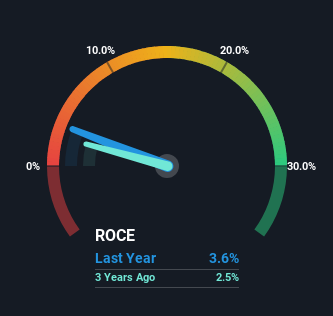
If we want to find a stock that could multiply over the long term, what are the underlying trends we should look for? One common approach is to try and find a company with returns on capital employed (ROCE) that are increasing, in conjunction with a growing amount of capital employed. Ultimately, this demonstrates that it's a business that is reinvesting profits at increasing rates of return. In light of that, when we looked at Hisaka Works (TSE:6247) and its ROCE trend, we weren't exactly thrilled.
What Is Return On Capital Employed (ROCE)?
Just to clarify if you're unsure, ROCE is a metric for evaluating how much pre-tax income (in percentage terms) a company earns on the capital invested in its business. Analysts use this formula to calculate it for Hisaka Works:
Return on Capital Employed = Earnings Before Interest and Tax (EBIT) ÷ (Total Assets - Current Liabilities)
0.036 = JP¥2.5b ÷ (JP¥82b - JP¥13b) (Based on the trailing twelve months to March 2024).
Therefore, Hisaka Works has an ROCE of 3.6%. Ultimately, that's a low return and it under-performs the Machinery industry average of 7.9%.
View our latest analysis for Hisaka Works

Historical performance is a great place to start when researching a stock so above you can see the gauge for Hisaka Works' ROCE against it's prior returns. If you want to delve into the historical earnings , check out these free graphs detailing revenue and cash flow performance of Hisaka Works.
What Can We Tell From Hisaka Works' ROCE Trend?
In terms of Hisaka Works' historical ROCE trend, it doesn't exactly demand attention. The company has consistently earned 3.6% for the last five years, and the capital employed within the business has risen 30% in that time. Given the company has increased the amount of capital employed, it appears the investments that have been made simply don't provide a high return on capital.
What We Can Learn From Hisaka Works' ROCE
In summary, Hisaka Works has simply been reinvesting capital and generating the same low rate of return as before. Although the market must be expecting these trends to improve because the stock has gained 52% over the last five years. Ultimately, if the underlying trends persist, we wouldn't hold our breath on it being a multi-bagger going forward.
One more thing, we've spotted 1 warning sign facing Hisaka Works that you might find interesting.
If you want to search for solid companies with great earnings, check out this free list of companies with good balance sheets and impressive returns on equity.
Valuation is complex, but we're here to simplify it.
Discover if Hisaka Works might be undervalued or overvalued with our detailed analysis, featuring fair value estimates, potential risks, dividends, insider trades, and its financial condition.
Access Free AnalysisHave feedback on this article? Concerned about the content? Get in touch with us directly. Alternatively, email editorial-team (at) simplywallst.com.
This article by Simply Wall St is general in nature. We provide commentary based on historical data and analyst forecasts only using an unbiased methodology and our articles are not intended to be financial advice. It does not constitute a recommendation to buy or sell any stock, and does not take account of your objectives, or your financial situation. We aim to bring you long-term focused analysis driven by fundamental data. Note that our analysis may not factor in the latest price-sensitive company announcements or qualitative material. Simply Wall St has no position in any stocks mentioned.
About TSE:6247
Hisaka Works
Engages in the manufacture and sale of industrial machinery worldwide.
Established dividend payer with proven track record.
Similar Companies
Market Insights
Community Narratives



